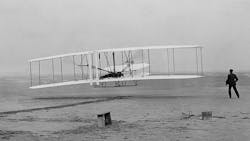Major General Michael Collins Honored with 2019 Wright Brothers Memorial Trophy
The National Aeronautic Association (NAA) is pleased to announce that Major General Michael Collins has been selected as the recipient of the 2019 Wright Brothers Memorial Trophy for, “his lifelong dedication to aerospace and public service in the highest order, both as a pioneering astronaut and inspired director of the Smithsonian’s National Air and Space Museum.”
Established by NAA in 1948 to honor the memory of Orville and Wilbur Wright, the trophy is awarded annually to a living American for “…significant public service of enduring value to aviation in the United States.” One of the most important, historic, and visible aerospace awards in the world, the Wright Brothers Memorial Trophy reflects a timeline of the most innovative inventors, explorers, industrialists, and public servants in aeronautics and astronautics.
Inspired by John Glenn’s extraordinary Earth orbit aboard the Friendship 7, United States Air Force test pilot, Michael Collins decided to become an astronaut. After completing the Air Force Aerospace Research Pilot School at Edwards, Collins was among the third group of 14 astronauts selected for training in 1963.
In 1966, Collins became the seventeenth American to fly in space as the pilot of the Gemini 10 mission. Two years later, Collins served as the CAPCOM for the Apollo 8 mission, which would be the first flight to leave low Earth orbit, reach the moon, orbit it, and return. As the sole person who communicated with the crew during the launch phase through the translunar injection, Collins managed the portion of the mission that ensured Apollo 8’s rocket burn to reach the moon.
For his second and final mission in space, Collins served as command module pilot for the historic Apollo 11 lunar landing mission alongside mission commander Neil Armstrong and lunar module pilot Buzz Aldrin. With the eyes of the world upon them, Apollo 11 was launched on July 16, 1969. As the command module pilot, Collins’ role was to continue orbiting in the command module “Columbia”, performing essential tasks that readied the capsule for the journey back to Earth, while Armstrong and Aldrin successfully traveled to the surface of the moon and back in the lunar module “Eagle”.
After the remarkable achievement of the Apollo 11 mission and its enduring value to mankind, Collins chose to take on a mission of a different type, serving as director of the Smithsonian’s National Air and Space Museum from 1971 to 1978.
Congress had approved the creation of the National Air Museum in 1946 without funds allocated for its construction. Despite the lack of essential support, it was always hoped that the facility would open in time for America’s Bicentennial on July 4, 1976. By the 1970’s America had become excited and proud of the successes in space and there was renewed interest in the (now named) National Air & Space Museum.
Collins ardently lobbied for funding and after persuasive petitioning by several influential leaders, $40 million was allocated for construction of the museum. Under Collins’ leadership, the Smithsonian’s National Air and Space Museum opened on July 1, 1976, receiving one million visitors in the first month and ten million in the first year.
Collins’ ability to show the educational worth of the nations most prized aviation and space artifacts helped to expand the museum physically, educationally, and financially, creating the gold standard for aerospace curation. The National Air and Space Museum stands today as a testament to Collins’ vision, dedication, and willingness to step up as the right man at the right time.
“To many, Michael Collins is known as a pioneering astronaut and for that work alone he would be an outstanding recipient of the Wright Trophy,” said Greg Principato, president, NAA. “But his commitment to public service was only getting started. We take the National Air and Space Museum for granted now, but the fact that it is the national treasure we know today owes more than most realize to the determination and leadership he showed in the face of great challenges. He has used his experience and notoriety in the years since to continue to educate and inspire. On so many important occasions, General Collins was the right person at the right time. Our nation owes him a debt of gratitude it can never repay, and it will be our honor at the National Aeronautic Association to present him with the Wright Brothers Memorial Trophy.”
“There is something special about ‘firsts.’ But firsts aren’t ‘onlies,’” said Major General Michael Collins. “Wilbur and Orville had each other. Neil, Buzz and I had each other and the hard work of hundreds of thousands backing us on Apollo 11. The National Air and Space Museum stands on the Mall as a testament to thousands who helped craft it into the wonder it is today. As symbolic as firsts are, their true value is that they pave the way for others to dare, to go, to explore. I am deeply honored to receive this award, and I will always look upon it as a collaborative achievement.”
2019 Wright Brothers Memorial Trophy Selection Committee Members:
- James Albaugh, Chairman, National Aeronautic Association
- Marion Blakey, 2013 Wright Brothers Memorial Trophy Recipient
- Edward Bolen, President & CEO, National Business Aviation Association
- James Bridenstine, Administrator, National Aeronautics and Space Administration
- Nicholas Calio, President & CEO, Airlines for America
- Daniel Dumbacher, Executive Director, American Institute of Aeronautics and Astronautics
- Eric Fanning, President & CEO, Aerospace Industries Association
- Paul Feldman, President, Aero Club of Washington
- William Garvey, Editor-in-Chief, Business & Commercial Aviation
- Lieutenant General Thomas Stafford, 2011 Wright Brothers Memorial Trophy Recipient




